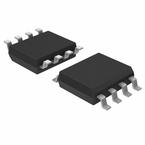The TPIC1021D is a Local Interconnect Network Physical Interface integrates the serial transceiver with wake up and protection features. The LIN bus is a single wire, bi-directional bus typically used for low-speed in-vehicle networks using baud rates between 2.4 and 20kbps. The LIN bus has two logical values: the dominant state (voltage near ground) represents a logic 0 and the recessive state (voltage near battery) and represents logic 1. In the recessive state the LIN bus is pulled high by the TPIC1021"s internal pull-up resistor (30kR) and series diode, so no external pullup components are required for slave applications. Master applications require an external pullup resistor (1R) plus a series diode. The LIN protocol output data stream on the TXD pin is converted by the TPIC1021 into the LIN bus signal through a current limited, wave-shaping low-side driver with control as outlined by the LIN Physical Layer Specification Revision 2.0.
● LIN physical layer specification revision 2.0
● Low current consumption in low power mode
● Wake-up available from LIN bus, wake-up input
● Dominant state timeout protection on TXD pin
● Wake-up request on RXD pin
● Control of external voltage regulator (INH pin)
● Integrated pull-up resistor and series diode for LIN slave applications
● Low EME and high EMI
● Bus terminal short-circuit protected for short-to-battery or short-to-ground
● Thermally protected
● Ground disconnection failsafe at system level
● Ground shift operation at system level
● Unpowered node does not disturb the network
● Green product and no Sb/Br
●Device has limited built-in ESD protection. The leads should be shorted together or the device placed in conductive foam during storage or handling to prevent electrostatic damage to the MOS gates.


